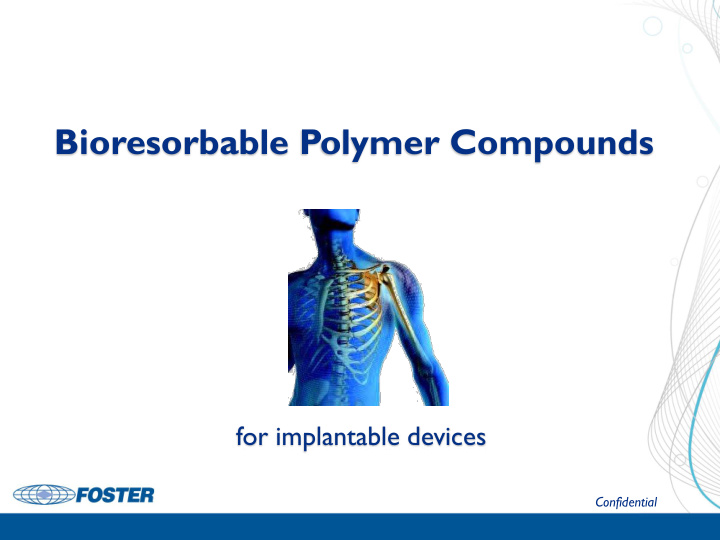



Bioresorbable Polymer Compounds for implantable devices Confidential
Bioabsorbable Polymers Attributes Synthetic Inert to the body; biocompatible Hydrolytically unstable Absorbed in body and metabolized Conventional melt processing Sterilizable with gamma and ETO Range of physical and degradation properties Property modification: molecular weight; copolymerization Confidential
Applications Sutures Dental devices Orthopedic fixation Controlled drug delivery Tissue fixation Biodegradeable stents Bone and tissue engineering Confidential
Bioabsorbable Polymers PLA – polylactides PGA – polyglycolides PLGA – poly(lactide-co-glycolides) PCL - Polycaprolactone Confidential
PolyGlycolides (PGA) Highly crystalline lower solubility in water Absorbs quickly loses strength within 1 month loses mass within 6 -12 months Melt point: 225 – 230 C Glass transition: – 35 – 40 C High modulus Confidential
PolyLactides (PLA) PLLA slow rate of absorption (>2 yrs) highly crystalline glass transition: 50 – 80 C melt point: 173 – 178 C high modulus (load bearing applications PDLA faster absorption rate than PLLA Confidential
Poly(lactic-co-glycolic acid) (PLGA) Copolymer Properties based on ratio of lactide to glycolide Amorphous Glass Transition: 40 - 60C Very good solubility Degradation depends on ratio of above 50/50 ratio absorbs in about 2 months Confidential
Polycaprolactone (PCL) Low melting point: 60 C Glass transition temperature: -60C Often used as additive to improve processing & end use properties Slow degradation rate (>2yrs) Confidential
Factors Affecting Biodegradation Chemical structure & composition Molecular weight & distribution Morphology ( amorphous/crystalline structure) Site of implantation Part shape and design Mechanism of hydrolysis (enzymes v. water) Processing & handling conditions Annealing Sterilization process Storage history Drying Presence of additives Confidential
Foster Experience Range of Bioresorble Polymer Compounds Small Volume Manufacturing 1/2 lb sample 10+ lb production Low/medium shear screw configurations Can hold tight tolerances Appropriate drying capabilities 2 plants environmentally controlled Las Vegas, Nevada facility Putnam, CT Packaging capabilities metalized bags, poly bags, vacuum canning Confidential
Recommend
More recommend